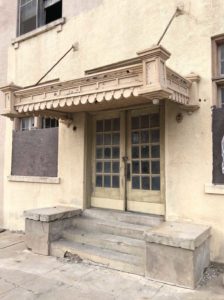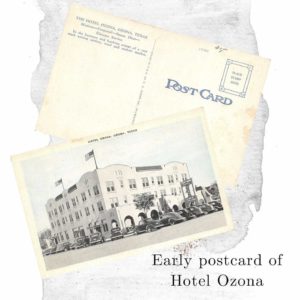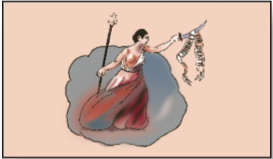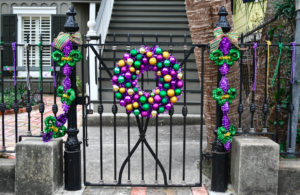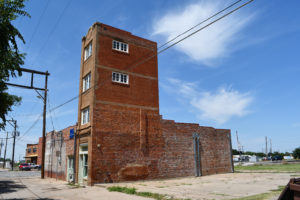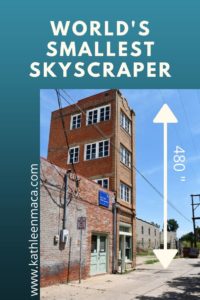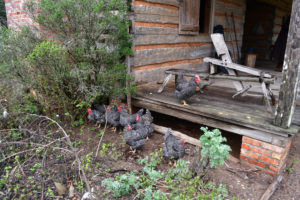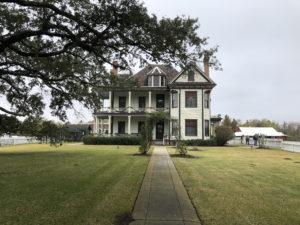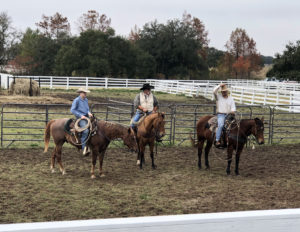Category: Uncategorized
Lone Star Monument and Historical Flag Park
There are two things that are guaranteed to bring a smile to a Texan’s face: The Lone Star Flag and bluebonnets. And as anyone who travels knows, the flag and outline of the state of Texas are symbols recognized around the world. We wouldn’t have it any other way.
The Lone Star Monument and Historical Flag Park in Conroe is an “outdoor museum” dedicated to sharing part of the st ory of the Texas Revolution. Its location is especially appropriate because Montgomery County is the birthplace of the Lone Star Flag that was voted and settled on by the Texas congress in 1839.
ory of the Texas Revolution. Its location is especially appropriate because Montgomery County is the birthplace of the Lone Star Flag that was voted and settled on by the Texas congress in 1839.
 At the entrance to the display is a five-foot tall granite pedestal topped by a bronze bust of Dr. Charles B. Stewart, who is credited with creating the design for our beloved State Flag of Texas. The artist, Craig Campobella, created the image from the only surviving photograph –and it was a blurry one – of the doctor.
At the entrance to the display is a five-foot tall granite pedestal topped by a bronze bust of Dr. Charles B. Stewart, who is credited with creating the design for our beloved State Flag of Texas. The artist, Craig Campobella, created the image from the only surviving photograph –and it was a blurry one – of the doctor.
Stewart also served as an interpreter between General Sam Houston and General Santa Anna at the Battle of San Jacinto, signed the Texas Declaration of Independence and was Texas’ first Secretary of State.
 Follow the path from the Stewart memorial up to the flag park, and you’ll be greeted by another bronze artwork, the 14-foot bronze statue standing in the center of the circle of flags. Named The Texian (a fighter in the Texas Revolution), the charging subject is brandishing the version of the Lone Star flag that appeared in the Republic of Texas three years after the Battle of San Jacinto.
Follow the path from the Stewart memorial up to the flag park, and you’ll be greeted by another bronze artwork, the 14-foot bronze statue standing in the center of the circle of flags. Named The Texian (a fighter in the Texas Revolution), the charging subject is brandishing the version of the Lone Star flag that appeared in the Republic of Texas three years after the Battle of San Jacinto.
And symbolism? It’s packed full!
13 rocks under the Texan’s left foot represent the 13-day long siege at the Alamo. And imagine how long it took the artist to make 354 marks on the rocks to memorialize each soldier massacred at Goliad.
Look for clues in the soldier’s clothing, too. 18 buttons on his shirt, coat and pants stand for the number of minutes the fighting went on at San Jacinto. His red sash is a signature of the Texas Army whose members tied them on the right hip when every other army tied them on the left.
View his tie and sash from the five o’clock position and you’ll see that they incorporate the Alpha and Omega, the beginning and the end, referring to the 5 p.m. hour on April 21, 1836 when the Battle of San Jacinto came to an end.
The nine Texians who died at San Jacinto are remembered with nine stones under the right boot.
This time of year, the mound that The Texian stands atop is planted in brilliant bluebonnets, making it especially delightful to see.
Lift your gaze and you’ll see a circle of flags flying overhead. Flags were used to communicate the spirit and identities of the brave people who battled for Texas independence. And although the six national flags that ha ve flown over Texas are more commonly known, many more have been carried in the Lone Star State. In fact, when the organizers of the park decided to fly 13 different flags to symbolize the 13 colonies of Texas at the time of the 13-day siege at the Alamo, they had to make their choices from over 50 flags!
ve flown over Texas are more commonly known, many more have been carried in the Lone Star State. In fact, when the organizers of the park decided to fly 13 different flags to symbolize the 13 colonies of Texas at the time of the 13-day siege at the Alamo, they had to make their choices from over 50 flags!
The story behind each of these 13 flags is displayed on a bronze plaque at the base of its 35-foot flagpole.
Coahuila Y Tejas 1821-1836
1824 Tri-color Alamo Flag 1835-1836
Texas Navy Flag 1836
Alabama Red Rovers 1835-1836
New Orleans Grays 1835-1836
Gonzales Flag 1835 Come and Take It
Sarah Dodson’s Tri-color Flag 1835
Troutman Lone Star Flag 1836
Goliad Flag, Severed Arm, Bloody Sword 1836
San Jacinto Liberty Flag 1836
First Flag of the Republic De Zavala Flag 1836
Second Flag of the Republic Burnet Flag 1836
Lone Star Flag 1839
You’ll find the Lone Star Monument and Historical Flag Park adjacent to the Montgomery County Library, at 104 I-45 North in Conroe. The park is free to visit and open seven days a week.
Does Bigfoot Hang Out in East Texas?
For my 11th birthday, my parents took a group of my friends and I to see a new movie: “The Legend of Boggy Creek- A True Story.”
If you need a good giggle, click here to see the original movie trailer.
It was a new scary movie (called a docu-drama) about a monster that lived in the swamps of Arkansas. (I know, I know…”swamps in Arkansas?”) Basically portrayed as a Bigfoot-like creature, this guy attacked and killed people. I remember not being very scared (even back then it took quite a bit to scare me), but my friends screamed and clutched each other through the entire thing. I don’t remember if I noticed that it was painfully obvious that this “Bigfoot” was a guy in an ape suit, complete with cutout eyes.
But as bad as it was, the movie holds a fun spot in my memories because, hey…it was my birthday.
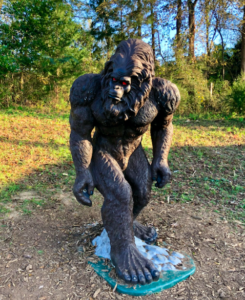 Just a few months ago I was speaking at a paranormal convention in Jefferson (about Victorian funeral customs). One of the gentlemen who had a booth in the vendor hall carried just about everything Bigfoot-themed you could think of: dolls, bumper stickers, books, key chains and more. I resisted as long as I could, but I finally politely asked him what connection Bigfoot had with East Texas.
Just a few months ago I was speaking at a paranormal convention in Jefferson (about Victorian funeral customs). One of the gentlemen who had a booth in the vendor hall carried just about everything Bigfoot-themed you could think of: dolls, bumper stickers, books, key chains and more. I resisted as long as I could, but I finally politely asked him what connection Bigfoot had with East Texas.
He looked at me as if I had lost my mind, and then asked if I had ever heard of a movie called “Legend of Boggy Creek.”
I smiled and replied that, well yes as a matter of fact I remembered that movie.
That’s when he told me that although the movie was set in Arkansas, those events actually happened in East Texas, where Bigfoot has been seen for years.
 A couple of other attendees gathered to tell me that OF COURSE it was about East Texas, and the movie had even been filmed there.
A couple of other attendees gathered to tell me that OF COURSE it was about East Texas, and the movie had even been filmed there.
Well, huh. Who knew?
I thanked them for the information, and sat myself down for a visit with Mr. Google. But all I really had to do was walk across the street from the convention area to see a bronze statue of Bigfoot.
The next day, I drove to Uncertain, which is appropriately named for anything spooky, and recognized the same type of swampy, cypress-filled waterways and run-down wooden shacks that appeared in the movie.
I didn’t get to meet Bigfoot, but maybe he rests during the day. Wherever he was, I found Uncertain to be a magical place, and can’t wait to visit again to go kayaking or on an airboat ride. It’s an ecological wonderland. But I’ll have to remember to keep an eye out for the Big Guy in the treeline.
Who wants to join me?
Dots and Dashes: Telegraph in Marshall
_ . _.._ ._ …
If it looks like I just accidently hit some random keys while beginning to type this, morse code might not be in your wheelhouse. The mysterious string of dots and dashes spells out the name of a place I love: Texas!
On 100 block of North Washington street in Marshall, facing their enormous courthouse, this life size bronze statue reminds passersby that the town holds a unique place in communication history. It sits on the spot where the first telegraph office in the state opened in February 14, 1854. Long-distance communication w-a-y before cellphones and emails made it something that we take for granted.
The Texas and Red River Company opened its Marshall office and strung wires all the way to Shreveport, which in turn had wires to New Orleans. By 1854 another line connected the town to Houston via other lines. That opened up a lot of business opportunities for the railroad town.
By 1870 there were about 1,500 miles of telegraph wire across the Lone Star State. Instead of riders on horseback an stagecoach carrying  handwritten messages for days, a series of sounds could be translated into words and handed to messenger boys as young as 10 years old who would deliver the messages on their bikes within minutes.
handwritten messages for days, a series of sounds could be translated into words and handed to messenger boys as young as 10 years old who would deliver the messages on their bikes within minutes.
Now here’s the part that’ll leave you scratching your head…
In 1838, Samuel F. B. Morse (the inventor of the telegraph) wrote a letter to Memucan Hunt. Hunt was a friend of Morse’s who just happened to be the Republic of Texas minister to the United States who had told the inventor countless stories about Texas. He had explained that although the republic had lots of land and heart…it was a bit short on revenue.
In the letter, Morse offered the answer to that problem by GIVING the rights to his incredible invention to Texas. Um, WHAT?!
 Somehow the letter, which had been forwarded to officials of the republic, ended up filed away, gathering dust.
Somehow the letter, which had been forwarded to officials of the republic, ended up filed away, gathering dust.
Y-e-a-r-s later in 1860, Morse wrote a follow up letter to Texas Governor Sam Houston.
“In the year 1838 I made an offer of gift of my invention of the Electro magnetic Telegraph to Texas … Although the offer was made more than twenty years ago, Texas … has never directly or impliedly accepted the offer. I am induced, therefore, to believe that in its condition as a gift it was of no value to the State … I, therefore, now respectfully withdraw the offer made then.”
Wow, talk about an opportunity falling through the cracks! Imagine how much money Texas could have made as the owner of that patent. Sigh…
So while this beautiful bronze statue reminds us of an immense accomplishment…there is definitely a “oops” factor attached!
Waxahachie’s Courthouse Square Kaleidoscope
Waxahachie courthouse Square kaleidoscope takes looking at the world through rose colored glasses one step further. The Internet active artwork created by Eddie and Mary Elizabeth Phillips sits on the corner of Main and College Street, just across the street from the fabulous Ellis County Courthouse. You overlook it if you’re as entranced with courthouse architecture as I am, but it’s worth looking for! It takes the cardboard kaleidoscopes of our youth to a while new level.
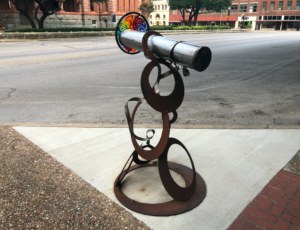 Built of scrap metal and stained glass, visitors can spin the glass wheel at one end and then look through the triangular opening at the other for a burst of ever changing colors. And the installation is near the corner streetlight it can even be enjoyed at night. (Good thinking!)
Built of scrap metal and stained glass, visitors can spin the glass wheel at one end and then look through the triangular opening at the other for a burst of ever changing colors. And the installation is near the corner streetlight it can even be enjoyed at night. (Good thinking!)
Click these links to see videos of this kinetic beauty in action, and then make a note to give it a spin yourself when you’re in the area!
Were you as fascinated with kaleidoscopes as a kid as I was?
Galveston’s Mardi Gras Houses
Looking for Mardi Gras festivities that are socially distant? Galveston Island has your answer.
Galveston Island has been celebrating Mardi Gras with citywide celebrations since 1871, and with private parties before that.
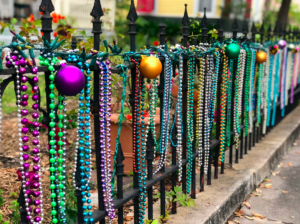 The town may be covered in sparkling lights for the Christmas season, but it bursts out in gold, green and purple for Mardi Gras. If you pass the houses at night and think you spot a Christmas tree inside a window, it’s most likely a Mardi Gras tree instead.
The town may be covered in sparkling lights for the Christmas season, but it bursts out in gold, green and purple for Mardi Gras. If you pass the houses at night and think you spot a Christmas tree inside a window, it’s most likely a Mardi Gras tree instead.

The annual parades have been cancelled this Carnival season for safety’s sake, but that won’t stop Galvestonians and their visitors from having fun. Taking a cue from New Orleans, instead of floats this year you’ll find “house floats” around the island.
Members of the Krewe of Saints who decorated their own homes complied a list of addresses so others can enjoy the fun. You can find an interactive map here.
 On Saturday, February 13th between 5 and 7 p.m., some of the participating houses will have beads and surprises for strolling revelers in their neighborhoods.
On Saturday, February 13th between 5 and 7 p.m., some of the participating houses will have beads and surprises for strolling revelers in their neighborhoods.
If you’re driving through the neighborhoods rather than walking, be aware that some of the streets are one way. There are often quite a few cars parked in front of the houses, making the streets narrower to navigate.
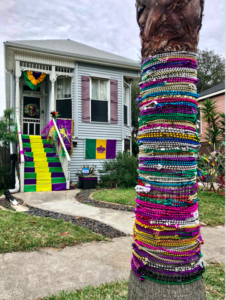 Of course, there are more homes decorated than the ones owned by this one Krewe, and the best way to see them all is to drive or walk the streets looking for the festive trimmings. If you only have a limited time, I would suggest exploring Sealy an Ball Avenues.
Of course, there are more homes decorated than the ones owned by this one Krewe, and the best way to see them all is to drive or walk the streets looking for the festive trimmings. If you only have a limited time, I would suggest exploring Sealy an Ball Avenues.
If you’re looking for some edible treats to keep up your Mardi Gras energy, you can find Mardi Gras bagels and cookies at Patty Cakes Bakery, king cakes at Maceo Spice Company and delicious seafood gumbo at the Black Pearl.
Have fun and Laissez les bon temps rouler!



World’s Smallest Skyscraper: How a Con Man Gave Wichita Falls a Claim to Fame
How could a city invest a fortune in a “high-rise” that’s only about forty feet tall? This building’s tale should appear in the dictionary as the definition of “hoodwinked.”
In 1912, a large petroleum reservoir was discovered west of the city of Burkburnett, a small town just outside of Wichita Falls. Of course everyone was pretty happy about the financial windfall that ensued, but it also brought more people and businesses to town that wasn’t prepared to house them. People were so desperate that they were even conducting business in tents pitched on street corners. What Wichita Falls needed was more office space!
There was a one story building on the corner of Seventh and LaSalle Streets built by Augustus Newby in 1906 that was ideally located near the downtown railway depot. One of its tenants, J. D. McMahon, had a construction firm in there and say what he thought was a shining opportunity.
 In 1919 he proposed to build a high-rise annex next to the Newby Building that would provide multiple floors of space for commerce to the boomtown. Sounds like a great idea, right? That’s what the city leaders thought, too.
In 1919 he proposed to build a high-rise annex next to the Newby Building that would provide multiple floors of space for commerce to the boomtown. Sounds like a great idea, right? That’s what the city leaders thought, too.
McMahon drew up impressive looking blueprints (though he wasn’t an architect) and showed them to potential investors, who forked over $200,000 in capital for the building’s construction. That’s the equivalent of $2.8 million in today’s money!
He proceeded with the construction of the skyscraper, but used his own construction crew to control and oversee the project.
Locals evidently turned their attention elsewhere as the building was being raised, because it was almost completed before they noticed that something was wrong. Their high-rise tower wasn’t what they had envisioned. Instead of the 480-foot structure thy expected; McMahon had built a 480-inch building.
The brick embarrassment was only eighteen feet deep, ten feet wide and each of the four floors had only 118 square feet of space on each of the four floors.
 It’s been referred to as a glorified elevator shaft, which is especially ironic since the crew originally hired to install an elevator backed out of the project. The only way to access the upper floors was by an external ladder (until an interior staircase was built years later).
It’s been referred to as a glorified elevator shaft, which is especially ironic since the crew originally hired to install an elevator backed out of the project. The only way to access the upper floors was by an external ladder (until an interior staircase was built years later).
Infuriated investors took McMahon to court, sure that they would find justice for the con. But they had one more surprise in store.
Even though the judge was sympathetic to their complaints, he had to rule in favor of McMahon. What none of the financers had noticed in their excitement and rush to sign off on the project is that the blueprint listed the building’s dimensions in inches – not feet. It was build to the specifications proposed – 480” not 480’. Oh, the different an apostrophe makes!
The narrow stairs that were built a few years later took up twenty-five percent of the interior space, making it even smaller.
How could the situation possibly be worse? McMahon had never gotten permission from the property’s owner, who lived in Oklahoma, to build on the lot!
Needless to say, the Newby-McMahon Building was quite an embarrassment for local officials. The oil boom ended shortly after the building was completed, and it was boarded up and fell into disrepair.
Once the economy regained its footing, several small businesses operated in the snug spaces of the structure, including a barbershop and restaurants. It is now home to an antique shop on the bottom floor, and artist studios above.
Luckily, the building has survived several potentially fatal events including a fire, a 2003 tornado, and attempts by locals to have it demolished.
Wichita’s City County granted $25,000 in funds for the building’s restoration in 2005. Now, it’s true that that’s as much as it cost to build it in the first place – but that was a different time. Now the people of this Texas town have a reminder of the oil boom, a curiosity of visitors and something to point to and tell an amazing tale.
It might be difficult to spot from a distance because there’s more “sky” than “scraper,” but it’s worth stopping by to see this scam-tastic little piece of Texas history.
Take a Seat in the Chairy Orchard
If quirky places speak to your heart, you definitely need to pull up a chair in Denton’s “Chairy Orchard.”

Long time friends Anne Pearson and Judy Smith, known as the “Chairy Fairies,” live in the houses on either side of the empty lot they’ve owned for 40 years and created this artsy attraction. Backing up to a creek, the lot is in a floodway so will never be able to be built on…so why not have some fun with it?

Judy started attaching chairs to a tree a few years back and called it the “Chairy Tree.” When Anne joined in the fun, the tree soon turned into an orchard! The chairs com from thrift stores, garage sales and curbside discard piles. Some are even let anonymously by admirers of the project.
 Mark Holderbaum, a friend of the crafty duo, built the archways for the site by welding about 30 metal chairs into a Chairy Arch. Judy’ son Terry built a giant chair and hr grandson Drew build the Chairy Totter.
Mark Holderbaum, a friend of the crafty duo, built the archways for the site by welding about 30 metal chairs into a Chairy Arch. Judy’ son Terry built a giant chair and hr grandson Drew build the Chairy Totter.
A collection of diminutive chairs cluster along the boards of the “Chairy-wood Fence,” and old and weathered chairs end their display days in the “Chairy Cemetery.”

Bring a picnic, bring a friend, bring a sense of humor and definitely bring your camera! The Chairy Orchard is open to everyone from dawn to dusk at 1426 Churchill Drive in Denton.

Christmas at the George Ranch 2020
Ready to peek into Christmas Past, Texas style? Let me take you on a virtual visit to the George Ranch Historical Park in Richmond where they’ve lassoed a wonderful event to share just that!
The annual Christmas at the Ranch event was a bit different this year due to additional safety protocols, but the staff couldn’t have created a more welcoming and fascinating day for their guests.
Founded in 1824, the George Ranch showcases the four homes of four generations of this Texas family, and this time of year they’re dressed up for the season.
My first stop was at the visitor center, where I was provided with a map of the ranch and demonstration schedule. The park is laid out in a mile long loop (yes, a MILE), and visitors can ride a tractor pulled tram from one stop to the next. But I highly suggest combining riding and walking when weather permits, to enjoy the natural surroundings.
I rode the tram to my first stop, the 1830s Jones Stock Farm dog trot cabin, and was greeted by the volunteers dressed in period costumes. The cabin and buildings are replicas of Henry and Nancy Jones’ homestead – one of the earliest settlements of Northeast Mexico. Nope, it wasn’t even Texas yet!
– one of the earliest settlements of Northeast Mexico. Nope, it wasn’t even Texas yet!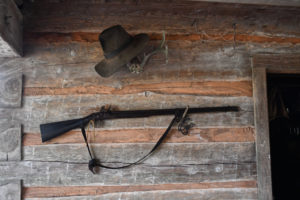
One gentleman shared the background of the family and information about the cabin, and another charmer played beautiful music on his guitar and told a few tall tales that were impossible to resist.
A young woman had the unenviable, sticky task of demonstrating how to clean a deer hide in a yard populated by adorable hens, but managed to do it with a smile while explaining that when the thin hides were worked until thy were translucent, they could be used to cover the cabin windows during the winter months (since glass wouldn’t have been available).
In the breezeway of the dogtrot a young man worked at weaving on a loom, taking breaks to serve visitors Mexican hot cocoa that was brewing over one of the hearth fires – and was a treat on the chilly day.

 In the nearby hog pen, one of the volunteers scratched the back of one of the docile 300-pound Berkshire pigs that are part of an initiative to preserve heritage breeds. Seems these fragrant residents are descendants of a rare breed that came to Texas from England in the 1830s. I know people who can’t trace their lineage as well!
In the nearby hog pen, one of the volunteers scratched the back of one of the docile 300-pound Berkshire pigs that are part of an initiative to preserve heritage breeds. Seems these fragrant residents are descendants of a rare breed that came to Texas from England in the 1830s. I know people who can’t trace their lineage as well!
 After a quick look at the chicken coop (always interesting to me since gathering the eggs was my job when visiting my grandmother’s farm), smokehouse barn and outdoor kitchen, I worked my way back to the road to hop on the tram again.
After a quick look at the chicken coop (always interesting to me since gathering the eggs was my job when visiting my grandmother’s farm), smokehouse barn and outdoor kitchen, I worked my way back to the road to hop on the tram again.
Next stop: the 1860s Ryon Prairie home – picture perfect with garlands of evergreens draped across the porch rails.
Mary Moore “Polly” Ryon was the oldest of the Jones’ daughters. She inherited th majority of her family’s wealth, and amazingly was on of the largest land holders in the region by age 18! She and her husband William built a cattle ranching empire after the Civil War.

 One young woman showed me around the knot garden and chicken coop until it was my turn (social distancing, ya know) to go inside the house.
One young woman showed me around the knot garden and chicken coop until it was my turn (social distancing, ya know) to go inside the house.
Inside two young docents explained the uses of the men’s and women’s parlors, and directed me toward the kitchen where more volunteers were baking cookies for the visitors in a period stove.
I decided to walk the rest of the property rather than ride the tram since it was a beautiful day and I didn’t see any reason to rush.
 Susan Elizabeth Ryan was Polly’s only surviving child and sole heir of Polly’s estate. She married banker civic leader John Harris Pickens Davis. The Victorian era home sits in a complex that includes a sharecropper’s farm, the family cemetery with graves dating between the 1820s to 1916 and the Oldenberg blacksmith shop. It seemed ironic to me that Polly isn’t in the family cemetery (she’s at Morton Cemetery in Richmond). But the existing monuments are beautiful and well cared for.
Susan Elizabeth Ryan was Polly’s only surviving child and sole heir of Polly’s estate. She married banker civic leader John Harris Pickens Davis. The Victorian era home sits in a complex that includes a sharecropper’s farm, the family cemetery with graves dating between the 1820s to 1916 and the Oldenberg blacksmith shop. It seemed ironic to me that Polly isn’t in the family cemetery (she’s at Morton Cemetery in Richmond). But the existing monuments are beautiful and well cared for. 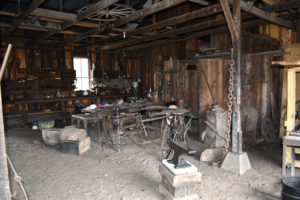
 In the blacksmith shop, kids were invited to try their hand at “forging” knives from chunks of clay with rubber mallets.
In the blacksmith shop, kids were invited to try their hand at “forging” knives from chunks of clay with rubber mallets.
In the side yard of the home, a sweet volunteer led visitors in creating Victorian style Christmas ornaments from paper as keepsakes of their visit.
The last home to tour was the 1930s George Ranch House (designed by famous Galveston architect Nicholas Clayton) and complex, where a barbershop quartet was entertaining passersby with Christmas carols.
Mamie George and her husband A.P. were the last descendants of the Henry and Nancy Jones family to oversee the ranching operation. Their influence and support is still seen across the community in libraries, schools, the Houston Livestock Show and Rodeo, a community center and countless other contributions. 
Their home is still decorated with their furnishings, right down to the ornaments on the Christmas tree! I loved Mamie’s collection of ceramic cowboy boots from her travels lined up on the mantle.
Once all of the home tours were checked off of my list, I headed to the arena and barn area for the cattle working demonstrations.
The cowboys demonstrated some basic cutting and lassoing techniques while explaining how and why these things are still down on the working ranch. Afterward, one of the cowboys walked the onlookers over to a dipping vat and related how they were used in the past – and why they aren’t any more (thank heaven!).
Whether you’re looking for a day out by yourself like I was, or for something for the entire family to enjoy together, I highly recommend a visit to the George Ranch. It’s beautiful, fascinating…and you might just pick up a little Texas history along the way.
Smitty, the Texas-sized Gingerbread Man
“Run, run, run as fast as you can
You can’t catch me, I’m the gingerbread man!”
Well, actually it’s pretty easy to catch up with THIS gingerbread man.
In 2006, the organizer of Smithville Texas’ annual Festival of Lights event baked up a delicious plan to take their celebration to the next level – by baking the world’s largest gingerbread cookie!
 Mixing together 750 pounds of flour, 49 gallons of molasses and 72 dozen (separated!) eggs, they created a Texas-sized gingerbread man. They n immense cookie sheet baked the 1,307 pound fellow on an immense cookie sheet over a dump truck load of charcoal (take THAT Food Network!) and then raised him with a crane to the 65 degree angle required by the folks at Guinness World Records for consideration.
Mixing together 750 pounds of flour, 49 gallons of molasses and 72 dozen (separated!) eggs, they created a Texas-sized gingerbread man. They n immense cookie sheet baked the 1,307 pound fellow on an immense cookie sheet over a dump truck load of charcoal (take THAT Food Network!) and then raised him with a crane to the 65 degree angle required by the folks at Guinness World Records for consideration.
Phew!
The staff at Guinness officially recognized the spied feat in the 2009 edition of their record book.
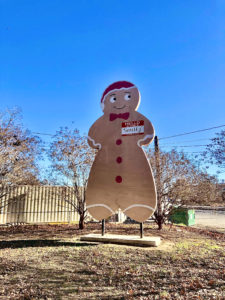 Now . . . how to memorialize the achievement? The Smithville Area Chamber of Commerce and the City of Smithville had the cookie sheet used to bake the gigantic gingerbread man converted into an enormous, 20-foot tall metal replica of the cookie, and the townspeople affectionately dubbed him “Smitty.”
Now . . . how to memorialize the achievement? The Smithville Area Chamber of Commerce and the City of Smithville had the cookie sheet used to bake the gigantic gingerbread man converted into an enormous, 20-foot tall metal replica of the cookie, and the townspeople affectionately dubbed him “Smitty.”
He stands in the town park making sure visitors can celebrate the spirit of Christmas all year long. Heads up, though, even though he towers over the park, he’s a bit hidden from the street by the trees in the park so you’ll have to get out of you car to see him in all his gingerbread-y glory.




